This was taken from: http://www.ushmm.org/wlc/en/article.php?ModuleId=10005214
Established in March 1933, the Dachau concentration camp was the first regular concentration camp established by the National Socialist (Nazi) government. Heinrich Himmler, in his capacity as police president of Munich, officially described the camp as "the first concentration camp for political prisoners." It was located on the grounds of an abandoned munitions factory near the northeastern part of the town of Dachau, about 10 miles northwest of Munich in southern Germany.
During the first year, the camp held about 4,800 prisoners. Initially the internees consisted primarily of German Communists, Social Democrats, trade unionists, and other political opponents of the Nazi regime. Over time, other groups were also interned at Dachau, such as Jehovah's Witnesses, Roma (Gypsies), homosexuals, as well as "asocials" and repeat criminal offenders. During the early years relatively few Jews were interned in Dachau and then usually because they belonged to one of the above groups or had completed prison sentences after being convicted for violating the Nuremberg Laws of 1935.
In early 1937, the SS, using prisoner labor, initiated construction of a large complex of buildings on the grounds of the original camp. Prisoners were forced to do this work, starting with the destruction of the old munitions factory, under terrible conditions. The construction was officially completed in mid-August 1938 and the camp remained essentially unchanged until 1945. Dachau thus remained in operation for the entire period of the Third Reich.
The number of Jewish prisoners at Dachau rose with the increased persecution of Jews and on November 10-11, 1938, in the aftermath of Kristallnacht, more than 10,000 Jewish men were interned there. (Most of men in this group were released after incarceration of a few weeks to a few months, many after proving they had made arrangements to emigrate from Germany.)
The Dachau camp was a training center for SS concentration camp guards, and the camp's organization and routine became the model for all Nazi concentration camps. The camp was divided into two sections--the camp area and the crematoria area. The camp area consisted of 32 barracks, including one for clergy imprisoned for opposing the Nazi regime and one reserved for medical experiments. The camp administration was located in the gatehouse at the main entrance. The camp area had a group of support buildings, containing the kitchen, laundry, showers, and workshops, as well as a prison block (Bunker). The courtyard between the prison and the central kitchen was used for the summary execution of prisoners. An electrified barbed-wire fence, a ditch, and a wall with seven guard towers surrounded the camp.
In 1942, the crematorium area was constructed next to the main camp. It included the old crematorium and the new crematorium (Barrack X) with a gas chamber. There is no credible evidence that the gas chamber in Barrack X was used to murder human beings. Instead, prisoners underwent "selection"; those who were judged too sick or weak to continue working were sent to the Hartheim "euthanasia" killing center near Linz, Austria. Several thousand Dachau prisoners were murdered at Hartheim. Further, the SS used the firing range and the gallows in the crematoria area as killing sites for prisoners.
In Dachau, as in other Nazi camps, German physicians performed medical experiments on prisoners, including high-altitude experiments using a decompression chamber, malaria and tuberculosis experiments, hypothermia experiments, and experiments testing new medications. Prisoners were also forced to test methods of making seawater potable and of halting excessive bleeding. Hundreds of prisoners died or were permanently disabled as a result of these experiments.
Dachau prisoners were used as forced laborers. At first, they were employed in the operation of the camp, in various construction projects, and in small handicraft industries established in the camp. Prisoners built roads, worked in gravel pits, and drained marshes. During the war, forced labor utilizing concentration camp prisoners became increasingly important to German armaments production.
The German police use this part of the camp today...
Watch Tower
Liberated by the US
The Entrance to the camp
The barracks (well, most of the camp) was burned down to hid all Nazi evidence after the war. They have reconstructed some buildings. Barracks like this would have filled the open spaces of Dachau.
This is a memorial to those who gave their lives by running purposefully into the electric fences.
My dear Karin. I love her.
Christian memorial
Jewish synagogue memorial
Words cannot describe the sadness that I felt as I walked through the somber Dachau camp. The hatred of a few changed the lives of so many. My heart will forever remember the pain of Dachau.
Afterwards, we ventured to downtown Munich for dinner and shopping.
Don't worry. They have a shrine to MJ on someones statue. I wonder how they feel...
The Glockenspiel in downtown Munich. PS--it was really cold. I wasn't planning on it being cold in July so my jacket, over a jacket, over a tie-dye dress is not attractive, though it was very necessary.
Hofbrauhaus--largest beirgarten in the US.
Dinner for Chris' birthday!










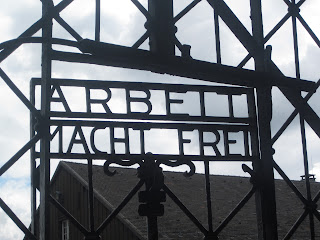

















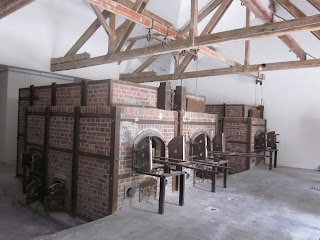





















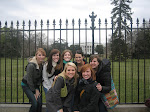
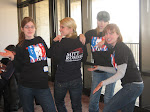

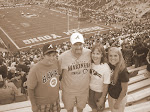
No comments:
Post a Comment